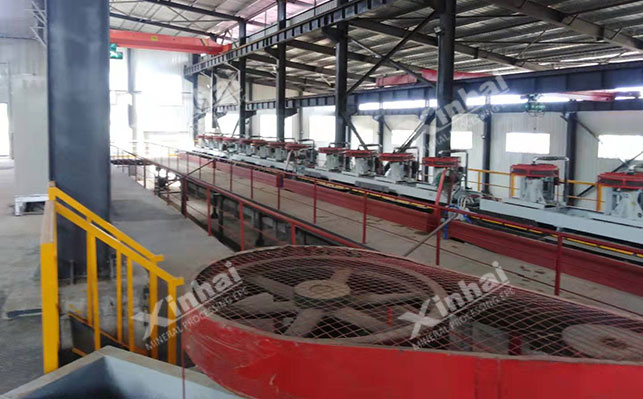Complex tin ore generally refers to tin ore with complex mineral composition and many associated minerals. The mineral composition usually includes cassiterite, sulfide, iron minerals, etc. In addition, this kind of tin ore has another characteristic of fine particle size and severe mud, so flotation is difficult. This article helps customers sort out flotation operation methods and provides direction for process optimization through a detailed introduction to the flotation process of complex tin ore.
(1) Crushing and screening
The first step of the flotation process of complex tin ore is to crush the mined ore. The particle size after crushing is usually less than 20mm. During the crushing operation, the vibrating screen cooperates with the crusher to complete the screening operation. The minerals under the screen enter the next process flow, and the minerals on the screen return to the crushing process for further crushing. It can usually be divided into several operation modes: coarse crushing, medium crushing, and fine crushing.
(2) Grinding and classification
In order to fully dissociate tin from other gangue minerals, the material needs to be further ground. At this time, the material is fed into the ball mill through the feeder. The grinding product is then classified by the classification equipment. The overflow of the classification enters the next process flow, and the underflow of the classification returns to the grinding equipment for further grinding until it reaches a dissociable particle size.
(3) Desludging and ore washing
The desludging and ore washing equipment is used to remove mud and fine impurities in the ore and reduce the viscosity of the slurry. The desludging process can be carried out by equipment such as trough ore washing machines or hydrocyclones.

(4) Slurry adjustment before flotation
Before flotation, attention should be paid to chemical adjustment of the slurry, mainly including adjusting the pH value, adding collectors and inhibitors, etc. The purpose of this is to enhance the hydrophobicity of tin minerals and create conditions for flotation.
(5) Flotation process
Flotation is the core link of complex tin ore processing. Common flotation methods include selective flocculation flotation, carrier flotation and flocculation flotation. Flocculation flotation refers to the process of adding flocculants to flocculate tin minerals to achieve separation. Carrier flotation uses larger particles of minerals as carriers to allow fine-grained minerals to adhere to them and float together.
(6) Treatment of middlings
The middlings produced during the flotation process need to be treated separately or returned to the process to recover the useful minerals therein.
(7) Concentration and scavenging
The functions of concentration and scavenging in the flotation process are different. The main function of concentration is to further improve the grade of tin concentrate, while scavenging is used to recover residual minerals in tailings.
(8) Tailings treatment
After flotation, the tailings need to be dehydrated. Xinhai tailings dry discharge process can control the moisture content of tailings below 20%, greatly reducing the impact on the environment. Common tailings treatment equipment includes thickeners and filters.
In the complex ore washing and flotation process, in order to obtain better flotation effect and mineral processing recovery rate, we can optimize the flotation process from several aspects such as the type and dosage of flotation reagents, and the setting of intelligent monitoring system. The specific methods are as follows:
(1) Process optimization direction
In the selection of flotation reagents, green and environmentally friendly flotation reagents can be selected while ensuring the flotation effect. This can not only reduce the impact on the environment, but also help reduce the investment cost for short-process flotation process.
(2) Application of intelligent technology
Intelligence and automation are the standard configuration of today's ore dressing plants. Through automatic control, the entire flotation process can be monitored in real time and problems can be solved in time. The advantage of intelligence is that not only data monitoring is more accurate, but also the workload of operators is reduced, which can be said to kill two birds with one stone.
The separation of complex tin ore is difficult. At the beginning of the flotation scheme design, the properties of various gangue minerals should be fully considered, and flotation agents should be selected for flotation separation in a targeted manner. In terms of optimization, attention should be paid to the application of environmentally friendly flotation agents, and intelligent technology should be fully utilized to achieve efficient production and achieve ideal mineral processing results.